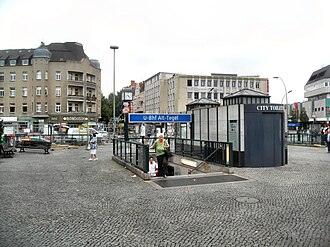Alt-Tegel underground station
The Alt-Tegel underground station is a station on underground line 6 in the Berlin district of Tegel in the Reinickendorf district . It is located at the intersection of Alt-Tegel / Berliner- / Bernstoff- / Gorkistraße and was opened on May 31, 1958 as the Tegel underground station .
history

As early as the 1920s, the city of Berlin had plans to extend the newly built north-south subway to northern Wedding, even to Tegel. The first construction work for an extension took place in 1929 in Müllerstrasse . Due to the imminent global economic crisis and the resulting financial consequences for the city of Berlin, the city stopped work. An approximately 400 meter long shell tunnel was created.
After the Second World War , the Berlin administration planned a massive expansion of the Berlin subway. The first new routes should also include line C, which at the time came from Neuköllner Grenzallee and ended on Seestrasse . The first celebratory ramming for a stretch between Seestrasse and Tegel took place on October 26, 1953, and the extension was to be implemented in two stages. First the Seestraße - Kurt-Schumacher-Platz section was under construction, followed by the partly above-ground section Kurt-Schumacher-Platz - Tegel. The second section included the stations Scharnweberstraße (above ground), Seidelstraße (now: Otisstraße , above ground), Holzhauser Straße (above ground), Borsigwerke (underground) and, as the terminus, Tegel, which was also underground.
The Tegel underground station, conceived as a terminus, was designed by the architect Bruno Grimmek . He designed the station sober and simple, the platform walls were given light blue ceramic tiles . Grimmek designed the pillars on the asphalt, 110-meter-long central platform with sand-colored, small mosaic stones. Like all underground stations on the two new sections of the route, the Tegel underground station also received a butterfly ceiling sloping towards the center. Two lobbies, one in the north and one in the south, serve to distribute the passengers to the six exits. In order to be able to fulfill the tasks of a high frequency traffic as a terminus, the station was also given an adjoining four-track sweeping system .
While the opening of the first section of the Seestraße - Kurt-Schumacher-Platz was celebrated on April 23, 1956, the inauguration of the second construction phase, including the opening of the Tegel train station, took place on May 31, 1958 by Willy Brandt, then Mayor of West Berlin . Since then, there has been another connection between the U-Bahn and the S-Bahn in the north of Berlin , with the Berlin-Tegel S-Bahn station about 400 meters away.
Contrary to many expectations, the northern section of the lines developed extremely positively in terms of passenger technology. The excursion traffic on the weekends in particular increased steadily, which is particularly evident from the division of Berlin, as West Berliners could no longer get to the lido in the East Berlin district of Grünau , which they used to visit .
In the rest of the history of the Tegel underground station, hardly anything happened. From 1984 it was no longer possible to change to the S-Bahn operated by the BVG. This was only possible from 1995, the Tegel S-Bahn station was now the terminus. Shortly before, however, on May 31, 1992, the Tegel station was given the new name Alt-Tegel as part of a renaming program for several West Berlin subway stations. The exact motives for giving the station this name are not known, possibly this was intended to distinguish it from the S-Bahn station of the same name, which was not in operation at the time.
At the beginning of 2006, the Berliner Verkehrsbetriebe commissioned construction companies with the first work for the construction of an elevator. In October 2006 an elevator system was completed directly from the platform to Berliner Straße. This means that the northern terminus of the U6, the twelfth station on the north-south line, has an elevator.
The middle of the three exits in the Alt-Tegel street was permanently closed on June 13, 2020. It will first be dismantled and closed with a concrete cover. The space created is to accommodate the renewed rectifier plant from 2021. Its old location will then be partially used to widen the exit towards the bus stops.
Connection
At the underground station there are direct transfers to the bus lines 124, 125, 133, 220 and 222 of the BVG . The Tegel S-Bahn station , served by the S25 S-Bahn line, is around 400 meters away .
Web links
- Area map of the train station (PDF; 806 kB)
- Entry in the Berlin State Monument List
- Description of the Kurt-Schumacher-Platz - Alt-Tegel route, including pictures
- More pictures at untergrundbahn.de ( Memento from February 13, 2013 in the web archive archive.today )
Individual evidence
- ↑ The U-Bahn is under construction - annoying, but necessary , press release from the Berlin transport company, March 1, 2006
- ↑ Two further underground stations accessible without barriers , press release of the Berlin transport company, October 2, 2006
- ↑ News in brief - U-Bahn . In: Berliner Verkehrsblätter . No. 8 , 2020, p. 170 .
Coordinates: 52 ° 35 ′ 22 ″ N , 13 ° 17 ′ 1 ″ E

